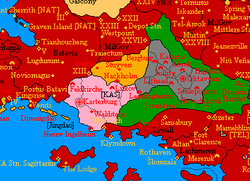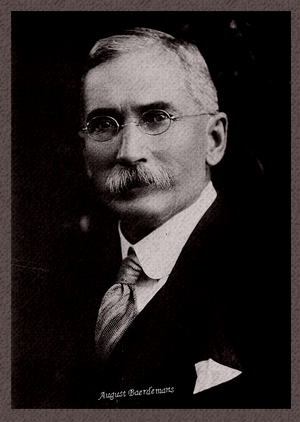Transbataafsche Vrystaat
| Transbataafsche Vrystaat | |||
| |||
| Motto: Werk. Bid. En Bewonder. | |||
| Anthem: Den Stem der Bataven | |||

| |||
| Map versions | |||
| Capital | Stuyven | ||
| Largest city | Jonkersberghe | ||
| Official language(s) | Official language: Batavian (Dutch), Jingdaoese, Shirerithian (English) | ||
| Official religion(s) | de facto: Bataafsche Nationale Kerk | ||
| Demonym | Transbatavian | ||
| - Adjective | Transbatavian | ||
| Government | Republic | ||
| - Vryheer | August Baerdemans | ||
| - Kanselier der Republiek(Head of the Lagerhuis) | Thomas Huiten | ||
| - Legislature | Lagerhuis and Hogerhuis | ||
| Establishment | 14.13.1659 | ||
| Area | NA | ||
| Population | ~295,879 (14.13.1659) | ||
| Active population | N/A | ||
| Currency | Transbataafsche Kruys | ||
| Calendar | |||
| Time zone(s) | |||
| Mains electricity | |||
| Driving side | |||
| Track gauge | |||
| National website | |||
| National forum | |||
| National animal | Regis batavius leo | ||
| National food | |||
| National drink | |||
| National tree | |||
| Abbreviation | TBV | ||
The Transbatavian Free State (Batavian: Transbataafsche Vrystaat) is a country located on the Benacian continent. It's one of the few landlocked countries on Micras and claims, just like the Kasterburger Republic a certain Batavian heritage. While parts of its lands are located in the former Batavian provinces of Hoorne and Ashkenatza Minor, its eastern areas were formerly part of Ashkenatza and Minarboria.
While the country covers both former Minarborian and Batavian lands, the nation is effectively ruled by Batavian settlers and it follows a harsh policy of Apartheid towards non-Batavians and Batavians with mixed blood.
Origins

The Vrystaat was established in the aftermath of the Grootu Trek Oostwaarts (1655 - 1659), a process in which Batavian refugees left the occupied (either by Jingdao or Shireroth) western lands to build their homes in the eastern lands, which were still free from influence of either side. These emigrations played an important role in the increase of farmers in the western parts of current-day Transbatavia.
In 1659 AN, the Batavians in the free, green territory noticed how the Shirerithian Empire was slowly but steadily attempting to establish control over the region. Several farmers rose up, joined a militia and fought back small groups of mercenaries whom had crossed the borders into the Green. After a minor victory at Jonkersberghe between 126 Batavian militiamen and 89 mercenaries, a free and independent republic was proclaimed by lieutenant-general August Baerdemans.
The newly declared republic soon received some monetary aid from Jingdaoese-Batavian organisations, like Hereenug het Vaderlant (Unite the Fatherland). While on a small scale, the organisations successfully sponsored immigration to Transbatavia. With the influx of new citizens and funds, August Baerdemans started a military expedition eastwards. The goal, to reach the border of Kalgachia, was reached after two difficult months.
Geography
Politics and government
When the Transbataafsche Vrystaat was established, the founders wanted to bring back the Batavian democratic traditions. The institutions of Hogerhuis and Lagerhuis were revived to honour its glorious past, in the hope to inspire the Transbatavians to do great deeds.
Vryheer
The Vryheer acts as the head of State of Transbatavia, but is (in theory) only called a temporary figurehead. The constitution claims to uphold the office of Vryheer until a reborn and independent monarchy is re-established to unite the Batavian peoples across the continent. In that sense, the Batavian settlers believe that the Vryheer plays the role of the regent and act as the representative of both the local Church and ancient traditions. Only someone from Batavian descent and with sufficient land (holding the title of Vryholder) is therefore eligible to run for the position. In the end it is the Hogerhuis which selects and votes for the Vryheer, who is in office for the next five AN years.
Kanselier der Republiek
The Chancellor of the Republic acts as president of the Lagerhuis and cabinet. When elected by the Lagerhuis, he presents the two chambers of parliament with a list of ministers and his plans for the next four AN years.
Hogerhuis
The Hogerhuis is the chamber of Vryholders. Each Batavian citizen who owns a large number of lands has the right to claim the title of Vryholder. The Hogerhuis decides upon issues like the appointment of the Vryheer, has to approve the yearly budget and approve the appointment of a new cabinet. It has a veto privilege on issues discussed in the Lagerhuis.
The Vryheer is the president of the Hogerhuis.
Lagerhuis
The Lagerhuis acts as the parliament of the Vrystaat. It has 20 seats and is elected by the Transbatavian peoples as a whole. However, during the voting process a Vryholder receives 2 votes, a normal Batavian voter receives 1 vote and a non-Batavian receives 1/2nd of a vote.
The institution passes laws, appoints the Kanselier van de Republiek (Chancellor of the Republic) who has to act as president of the Lagerhuis (but receives no extra vote) and government.
Administrative divisions
Foreign Affairs
Demographics
Military
The Vrije Weermacht is the gendarmerie and military force of the Vrystaat. It was established as a loose militia under lieutenant-general Baerdemans in 1657 to combat the increasing number of bandits.
Culture
Education
Religion
Entertainment
Economy
For a long time (especially in the west), since the collapse of the Batavian Kingdom and the retreat from the Jingdaoese from the region, the local population was mostly dependent on its own farm lands to survive. In larger villages, people sometimes used foreign currencies, like the Jingdaoese Kala or - with the expansion of Shirerithian influence - Erb. More frequent was the use of the Batavian Kruys, in most cases with a simple stamp on the billets to show from which village the currency came from.
The first Transbataafsche Kruys follows that tradition: as the government has not yet streamlined the production of its own billets, nor did it start minting its own coins.

